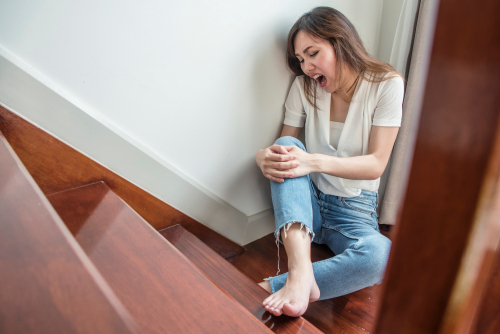The term “slip and fall” is used for personal injury cases in which someone slips, trips, stumbles, or loses balance on someone else’s property and falls, sustaining damages or injuries as a result. Slip and fall cases are a subset of premises liability claims. They can occur on business, government, public, or private property. If you slip and fall on someone else’s property, your slip and fall is a personal injury. The property owner or possessor may be liable for your damages.
How Slip and Fall Accidents Occur
There are many factors that can cause a slip and fall accident to occur. Some examples include:
- Torn carpeting that can catch someone’s foot.
- Changes in flooring from smooth to rough surfaces, or vice versa.
- Poor lighting in parking lots, stairwells, and thoroughfares.
- Narrow stairways or missing railings.
- Ice, rain, or other liquid spills that can lead to slippery floors.
- Damaged public sidewalks or roads, potholes, and unexpected bumps.
If you suffer an injury or damages in a slip and fall accident on someone else’s property due to their negligence, you may have grounds to file a civil liability case against them.
Common Slip and Fall Injuries
According to the Centers for Disease Control and Prevention, slip and fall accidents are the leading cause of traumatic brain injuries for the elderly, and over 95% of all elderly hip fracture cases are a result of falls. About 20% of these falls result in a serious head injury or broken bones. Fractures, sprains, and bruising are common injuries that slip and fall victims suffer.
When you include data on slip and fall accidents for the general public, the statistics are even more alarming. Hundreds of billions of dollars in damages, medical expenses, time missed from work, insurance processing, and legal costs are lost every year from preventable slip and fall accidents. The issue is so severe that the Department of Health and Human Services provides industry-specific guidance on how to prevent slip and fall accidents to help reduce such incidents.
Establishing Fault for Slip and Fall Accidents
It can be difficult to establish fault for a slip and fall accident because there are so many factors–many of them hard to prove–that may play a role. First, you must consider whether or not a property owner knew about a slip and fall hazard, and if they did, what they did to address it.
Next, carelessness on the part of the victim must also be considered. It is possible that the property owner put up signs and warnings to address premises hazards, but the victim simply did not see them.
A term that is often used to describe premises hazards is “dangerous conditions.” A dangerous condition is something that presents an unreasonable risk to visitors, patrons, guests, or employees on a property. They are events or factors that the property owner or possessor could conceivably have planned for based on the nature of the property, experience, or other factors such as the weather.
Generally speaking, you may be able to hold a property owner or possessor liable for a slip and fall accident if you can prove that:
- An owner or possessor created a dangerous condition.
- An owner or possessor knew about a dangerous condition but failed to correct it.
- A dangerous condition existed for long enough that an owner or possessor should have discovered and addressed it before an accident occurred.
- You suffered a slip and fall personal injury accident because a dangerous condition was not adequately addressed or corrected in a timely manner.
- You suffered physical, mental, or monetary losses as a result of your accident.
Several important legal precepts or concepts can be extracted from these requirements. Firstly, you must be able to prove that a property owner or possessor knew of a premises hazard. Proving that he or she did not take adequate steps to address the hazard is another issue. Is signage enough? What defines maintenance as “regular” or “adequate?” What suffices as proof of a slip and fall? How can you prove that your carelessness was not the cause of an accident? An attorney can help answer those questions;
We Can Help With a Claim
Our slip and fall personal injury lawyer team at Gacovino, Lake & Associates, P.C. has years of experience handling civil liability cases. We can help you identify the party or parties liable for your injuries and gather the evidence needed to prove your claim. We can also help you determine which injuries you may be able to file a claim for. Contact us today at (631) 600-0000 to speak with a member of our team.
